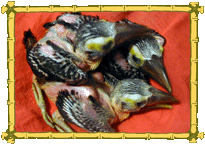|
|
The blessing and curse of surplus The best bit of husbandry advice I ever got came to me the end of summer 2002. That summer the American Federation of Aviculture (AFA) had its annual convention in Tampa, Florida. I went to the convention and listened to a presentation made by , Assistant Curator of Birds at Disney's Animal Kingdom. Ms. Plasse’s advice was simple: prepare for surplus. Surplus means more birds than you can sell, keep, or give to friends and family. The average person might assume that surplus is precisely the “problem” every breeder wants. It isn’t. If production peaks at a time when sales have slowed, there can suddenly be a surprising number of birds to tend. More birds requires more of everything: more work, more feed, more cages. The breeder who fails to prepare for surplus can be faced with a crisis. (Open this link to download the Word document Breeder Burnout written by .) On the other hand, with the proper preparation, surplus can be worth more than just additional income. Surplus eliminates any need to replace birds lost to age, health failure, or accidental death. This type of in-house restocking avoids the waste and frustration of purchasing, quarantining, and acclimating new birds. More importantly, restocking with surplus eliminates all risk of inadvertently introducing disease by introducing an unhealthy bird to your flock. In the words of Chelle Plasse, “Having the space to hold back-up birds in a safe and well cared for situation is a ‘good thing’.” To prepare for surplus, consider these common sense quidelines: • Make an accurate assessment of your cost per bird in terms of time and money, remembering to include both one-time (construction, cages, incubators, etc), and on-going costs (labor, feed, advertising); • Estimate your average annual production; • Ready the resources necessary to retain for twelve months or more all birds produced in an average year. David Foley • 407 721-6132 • |
